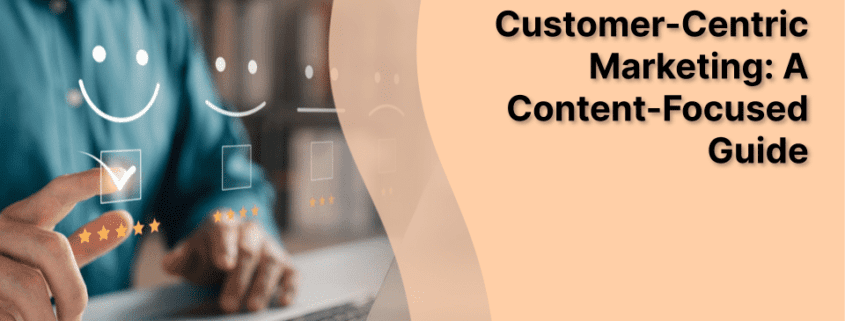Customer-Centric Marketing: A Content-Focused Guide
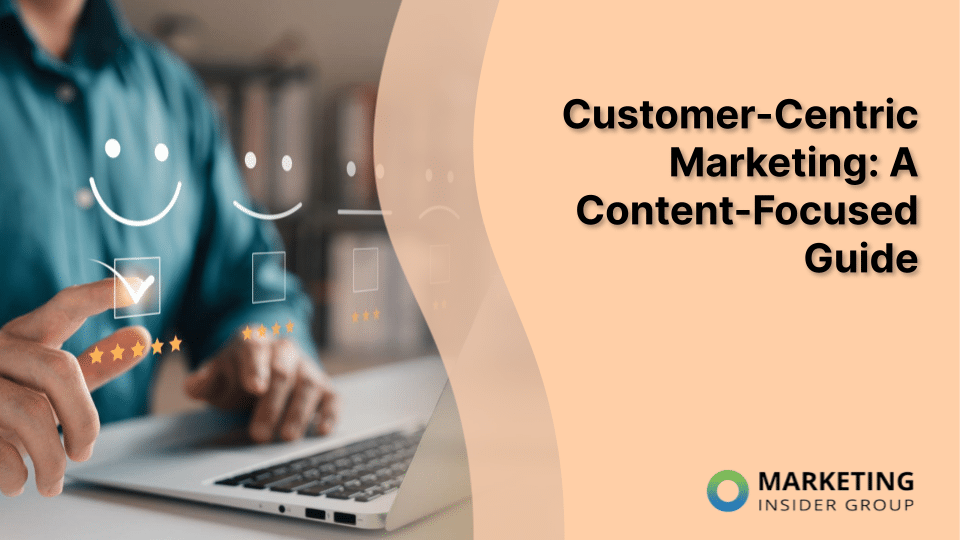
Dear marketing professional, meet your new (very demanding) boss… Your customer.
Today, top marketers are using content marketing not to persuade, but to engage with the consumer, meeting buyers where they stand, providing what they want.
With a great experience, customers are 5X more likely to make a purchase. From visiting your website to learn about your brand, making a purchase and getting a response from customer service, to staying up to-date on your social media channels with what’s going on with your business, every interaction should be seamless, fluid, and positive for the consumer.
How exactly can you master the art of ‘customer first’? How can you ensure that your messaging is going to evoke those feelings of being included, appreciated, and inspired that you want your customer to feel when they visit your site or open an email? You need to create the content that your audience wants.
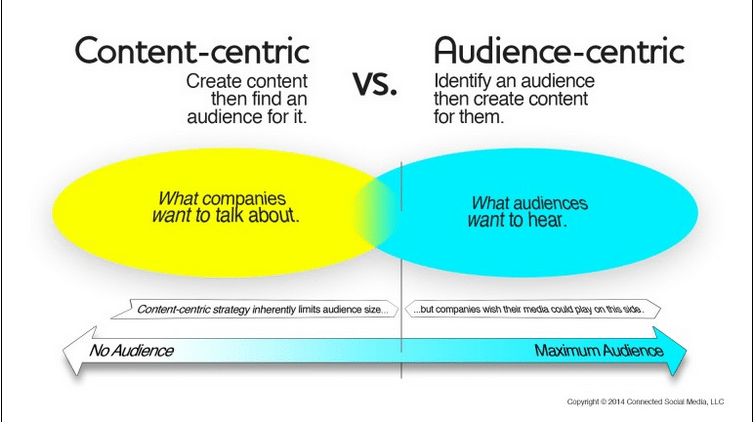
Customer-centric businesses are 60% more profitable than those that are still driving their brand-focused strategies. In order to remain competitive today, providing value-driven content is essential. When your inbound marketing is done brilliantly, it won’t just generate more leads. It will establish lasting relationships with your buyers.
This is the gold of good marketing. Repeat customers spend 67% more than new ones, on average.
So what can you do to ensure that all your digital content knocks the socks off of your audience?
Understand the Customer-Centric Marketing Model
The customer-centric marketing model is nothing new. Nor is it surprising that it is so effective at engaging customers and driving growth – what customer wouldn’t enjoy getting more from the brands they engage with, and as a result, gravitating towards those brands? Customer-focused companies are known to be 60 percent more profitable than those that aren’t.
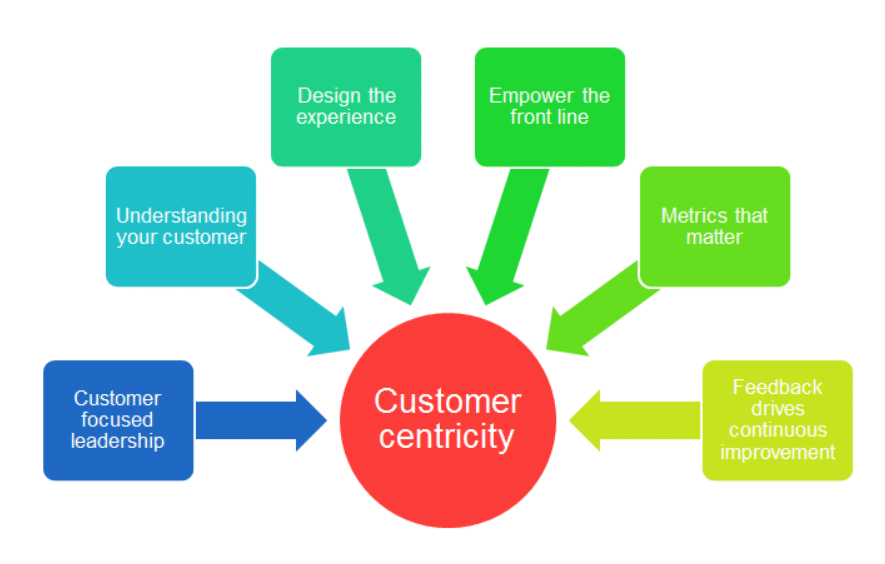
Think about it, today we take for granted the information we get from our CRM and the ease with which we can connect with our target markets via multiple platforms. Segmented email campaigns, user-generated social media content, brand ambassadors who truly want to be a part of our brand communities and invite others onboard.
These things weren’t part of mainstream modern marketing until recently.
CMOs putting a priority on being more customer-focused is part of the shift that the industry is going through. With better marketing technology and the insights gained from digital empowerment, marketers can do more. This priority shift is the part in the process where the customer focus, and subsequent experience, gets more dynamic. Where before, the strategy was to offer content in a couple places to attract and maintain interest, such as a blog and email newsletter, now the strategy is to provide content at every touch point – and it has to be content with character.
Know Your Buyers as Well as Your Old College Roommates
Listen, watch, observe – and dig. Read what consumers in your industry are saying on social media to discover pain points. Put out customer surveys when someone visits your website or makes a purchase. Read customer reviews for your business – and your competitors.
Spend the time to make your buyer personas come to life.
You need to get to know your buyers like an old friend, becoming able to anticipate their needs, recognize their style preferences, and understand the best ways to communicate with them. You also want to know their goals ( in relation to your brand) and what it is that they value the most (quality, customer support, cutting-edge style).
When you know your audience is looking for ways to get more out of your product, post how-to videos on YouTube or offer educational white papers on your website. If consumers are consistently raving about the quality of your competitor, then you know exactly what to focus on for your next campaign.
The more deeply you know your buyer personas, the better you will be able to craft content perfectly suited to them. And guess what? The more your content speaks to them, the more they’ll respond by signing up for your newsletter, following your brand on social media, or making a purchase.
Create an Emotional Attachment
Consumers feel a greater affinity for a brand they can make an emotional connection with. When 1,400 advertising campaigns were evaluated, those that were purely emotional turned out to be 31% effective. The purely rational were 16% effective. Combined campaigns were 26% effective.
For example, families are more likely to trust (and buy from) brands that express care and concern.
20-somethings want to feel excited and involved. Make your next campaign to target your younger audience feel like a social movement and see what type of reaction you get.
A study on human emotion found that our feeling spectrum is founded upon four basic emotions:
- Happiness/joy/serenity – which encourage sharing
- Sadness – promotes empathy and connectedness
- Fear/surprise – can trigger bonding
- Anger – creates stubbornness, as well as energy and action
You can use these guidelines to help work with emotion within your content, encouraging a greater response with your customers and helping to leave a greater impact.
Learn to Listen
“Most people do not listen with the intent to understand; they listen with the intent to reply” – Stephen Covey.
Once you’ve isolated your audience, it’s time to truly listen to them. Pay attention to the conversations you’re having with them. Are you offering them the right content at the right moment across their journey? It’s important to shift your story based on the questions your buyer is asking. Ardath Albee, CEO of Marketing Interactions, suggested marketers ask themselves, “Is your content relevant to them at that moment? Are your buyers on the channels you think they are?”
SnapApp CEO Seth Lieberman argued there are three things to listen for: Doing (behavior); Thinking (resonance); and Saying (sentiment).
How to do it:
- Pick your KPIs (you have to know what you’re looking for)
- Wallow in the data (understand the nuances and ebbs and flows)
- Ask why
- Look for correlation then causation
- Don’t over-engineer
- Test test test
When companies step outside of their bureaucratic mindset and embrace a more collaborative, agile view of how to do business, they leapfrog over the legacy brands that drag their feet to the ad agencies year after year.
As Stanford’s Nilofer Merchant put it, “…to consider new ideas, you have to be willing to let go of ones that no longer serve you.”
Bingo.
I’d take that one step further. In that process of collaboration that Merchant rightly advocates comes the need to listen to others’ perspectives. The more that collaborators put themselves in each other’s shoes – and their customers’ – the more effective collaboration will be.
In a word, empathy.
Mind you, empathy isn’t all about messaging that connects with your audience and customers; that messaging needs to extend into your replies to criticism as well. Though unkind comments might sting at first, they often are opportunities to make a difference – and a customer for life – depending on your response.
Use their feedback as a springboard for change. Reframe it as target customer research, and you can see negative comments as your chance to win these customers back. Who knows? If your response meets their needs, you might even get some referrals out of your efforts.
When you take marketing out of its silo and realize that it often spills over into customer service and research, your content and messaging will be among the select few that your target audience consumes and even actively seeks out.
Stop Short of Marketing Overload
As someone who does content marketing for a living, AdAge is practically required reading. Not so much for what it teaches us about modern marketing. More so for the comic material it provides that marketing is so much more than advertising.
As I sat down to leaf through the articles one August afternoon in 2016, something unusual caught my eye.
An article – in the old school marketing industry’s bible – that questioned the validity of excessive marketing. A wake-up call that made me realize that above anything else, empathy is essential for effective marketing in the coming decade.
It was an argument that I’ve been making for some time. To see it in this legacy advertising industry publication, though, took me aback. I had to read more.
That article was Jack Neff’s superb “Are Brands Optimizing Their Marketing to Death?” As I read, I found myself nodding in agreement as I realized that here was someone – in the marketing and advertising industry, no less – that saw the same trends that I did.
His insights inspired part of a chapter in Mean People Suck. That chapter, “Our Customers Know We Suck,” speaks to marketers’ tendency to solve revenue and website traffic challenges with – you guessed it – more marketing campaigns.
In reality, as Neff points out, the “more campaigns” strategy looks to be as dated as the slick cigarette ads of the 1960s:
And – like cigarettes – too many of the same ads can cause an early demise for companies that insist on running them. I’ve used this ad in some of my marketing keynotes. It’s pure gold. And not in a good way. There’s a whole story behind this ad that is even worse. Ask me about it some time!
Procter & Gamble, for instance, discovered that when they cut back on some of their targeted Facebook ads, they experienced a surprising outcome: their sales increased!
One of the reasons, Neff points out, appears in a recent Advertising Research Foundation study. That study revealed that if someone sees a digital banner ad over 40 times in a month, sales begin to drop. In fact, as a Key Media Solutions post pointed out, after only ten views of an ad, we become annoyed – even angry.
Who in their right mind thinks running annoying ads is a good idea? Apparently, plenty of brands.
- Even though 200 million-plus people are paying good money for ad blockers to stop these ads.
- Consumers reject brands that bombard them with annoying or irrelevant content. Is that so hard to understand?
- Even though studies reveal that 61 percent of consumers are influenced by custom content that helps them live better lives and make more money.
Why? Perhaps it’s because no one inside these brands – with the notable exception of Procter & Gamble and others that have escaped the bureaucratic matrix – dares to tell the emperor that he’s buck naked.
Focus on Delivering Value to Customers
The only kind of marketing that helps businesses connect with real people is personal content. Not just targeted, or personalized – personal content.
By connecting with consumers, marketers can see real business results. Brenner shared a study that Jim Stengel, the former CMO of Proctor and Gamble, conducted, revealing that brands that focus on connecting with their consumers on an emotional level have a growth rate triple that of their competitors.
Andrew Gaffney, Publisher of Demand Gen Report, noted that it can be a huge competitive advantage if you can figure out if what you’re talking about matters to your audience. As SnapApp CEO Seth Lieberman put it: Your only job (as a marketer) is to deliver value to your audience.
OK, so how do you deliver value?
Even when you’ve acknowledged that knowing your buyer is key to a successful content strategy, it can be difficult to get started. Marketers can get overwhelmed by all the persona options.
Erin Provey, Service Director at SiriusDecisions, shared her three-step plan with the crowd:
1) Isolate the audience. Simply make the conscious decision to choose a buyer!
2) Really get to know them.
3) Understand the environment in which they’re operating.
She stressed that, “Buyer-centricity is a philosophy. Buyer-specificity is a best practice.”
Step into Your Customers’ Shoes
As branding expert Derrick Rozdeba points out, on any given day, your customers are “bombarded with over 5,000 brand messages.” Of that 5,000, Rozdeba notes, only 12 get customers’ attention.
You can overcome that saturation with content that gets their attention from the first sentence to the final paragraph. “How?” you ask.
Rozdeba put it well: “Put our branding feet into the consumer’s shoes for a day.” When you streamline your customer journey by putting customers’ needs at the forefront of your messaging, you get their attention.
When you put yourself – and your marketing team – in your customers’ shoes, you’ll look at those statistics and run as far away as you can go from “those” ad agencies. You’ll do the research yourself (or outsource the research to a like-minded agency like ours) and find out who your customers are. You’ll learn what keeps them up at night. You’ll identify what they really need.
And, after you’ve learned the answers to those questions, you’ll create content that speaks to them. Content that soothes their three-o’clock-in-the-morning woes.
Contrast that with Coca-Cola’s misstep a few years ago. Instead of replacing their chief marketing officer (CMO), they eliminated the role altogether, replacing it with that of a “chief growth officer.” (They’ve since re-hired one.)
Talk about navel-gazing. Instead of a customer-focused role (marketing, after all, involves outreach), they focused on a company-focused role (growth – about as self-serving as it gets). And now their CEO is admitting that he sees “limited effectiveness in brand advertising.”
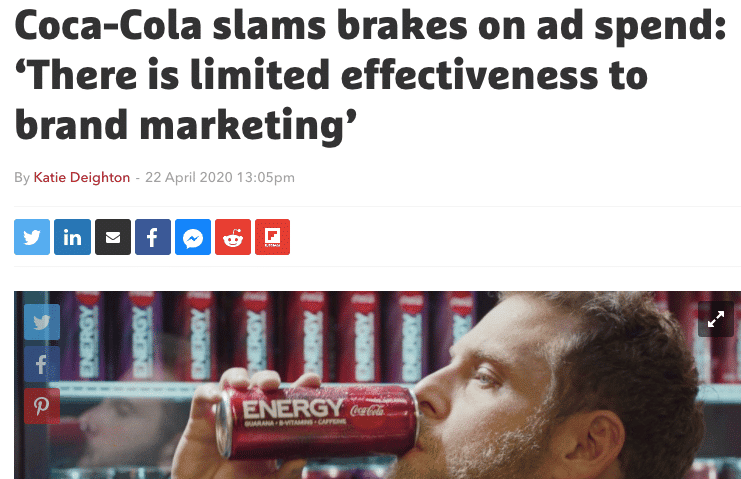
The CGO fulfilled his role to a T. At least, at first. In announcing the new role, he stated the philosophy that led to this change, “If you want people to love to drink Coca-Cola, please show in your commercial people who love drinking Coca-Cola…”
His mocking tone in criticizing the brand’s former tone wasn’t lost on E.J Schultz, the AdAge writer who reported on the change. Gwynn pointed out that the CGO role’s new direction veered off its old “Open Happiness” tagline to “re-Coca-Coliz[e]” the drink. Whereas the previous content iteration emphasized a customer benefit – happiness – the new philosophy and related content would be variations on the product-centric theme.
It didn’t last long. In December 2019, Simon Gwynn reported in PR Week, the beverage giant retreated to its previous structure, tapping Manolo Arroyo to assume the recreated CMO role.
In fact, even during the tenure of the CGO, Francisco Crespo, the company discovered that it needed to tap into customer benefits.
Coke’s superb Ramadan ad, portraying the beverage as the perfect drink to quench the thirst that built up over hours of going without eating or drinking, demonstrated that customer benefits – the “Open Happiness” vibe – won the day after all.
The beverage giant, as it did back in the 1980s with “New Coke” – another bad management decision – overcame its misstep with the power of empathy.
Make Relationship Building and Gratitude a Brand Priority
The driving force behind the move from brand-centric to customer-centric is the evolution of the customer relationship from ‘me’ and ‘them’ to ‘we.’ The more you can make your customers feel like they are a part of your brand, the more likely they are to stay tuned in and continue being loyal customers.
Great customer service, thoughtful social media and email marketing, and worthwhile loyalty programs can all help strengthen the bond between brand and buyer.
Whole Foods does an excellent job of relationship building, posting social media content that makes followers feel like a good friend.

The tone is warming, engaging, and encourages interaction. This is the type of marketing that keeps consumers coming back.
Loyalty programs may take significant time and effort to set up, but once they get going they are easier to manage. When done well, they can be a simple way to help your business grow and make your customers feel loved and wanted. And it can be used as another source of market research, revealing which rewards motivate your customer base.
Possibly even more effective, and less expensive, is a simple expression of gratitude. A study found that 91% of customers are more likely to purchase from a company that shows appreciation. Anything from a thank you note along with a product to a genuine email or phone call can ensure you’ve got a friend for life in your customers.
Continually Refine Your Content to Reflect Customers’ Priorities
How well is your customer-focused content working? This is where you can look at the qualitative as well as the quantitative data, through customer surveys, feedback, and reviews, and make an assessment. You can always improve your approach, whether you need to spend more time educating your buyers on how to use your products, inject more storytelling and personality into your content, or even improve upon or expand your services to respond to customer needs.
To get an overall idea of how well your content is doing, track your churn rate over time. This will show you how many customers you are losing. A 10% annual churn rate is average for most industries. If you can keep your numbers below this benchmark, and ideally getting smaller, then you can be confident that you are going in the right direction.
Content marketing is an incredibly effective and budget-friendly way to market your brand, but it only truly can work when your content is created for the consumer. If it’s not, you might be publishing articles, tweeting, and posting videos – to the wall.
Plan for Greater Customer-Centricity
CMOs have a few tricks planned for the next couple years to make this happen. When SiriusDecisions asked global CMOs what marketing trends they plan on using, here’s what they said:
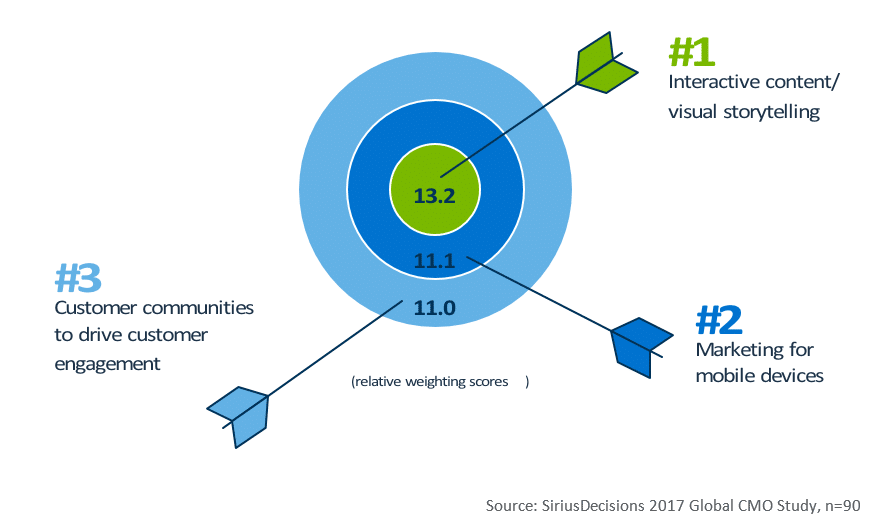
1. Interactive content – Preferably the tech-driven, augmented reality, 360-degree video kind.
2. Visual storytelling – There are two choices for CMOs going forward. Marketing teams with resource-packed in-house video production teams or working relationships with a video production agency. Video and other types of visual content are playing a bigger role, but they are also getting more imaginative, futuristic and high-tech.
3. Mobile marketing – This isn’t just mobile-responsive websites. It also encompasses dealing with the consumer shift to smaller mobile: smartwatches. This will change the way we engage with customers at different touch points. We’ll have to adopt SEO strategies that are better aligned with voice search and start veering towards better quality audio content.
4. Customer communities – This is a big one. It is being able to invite customers into an experience – a brand ‘world.’ It will include everything from more sophisticated online forums and content libraries to more social media interaction and in-person events.
Overcome Challenges to Customer-Centric Marketing
If there weren’t any obstacles to achieving customer-centricity, the role of the CMO or Marketing Head wouldn’t be any fun. The biggest barriers cited by global CMOs are insufficient organizational readiness and not enough data.
Of the 300 B2B marketing leaders surveyed, 79 percent did say their organizations are somewhat empowering regarding culture transformation. Somewhat is, however, not enough for dealing with the challenge of poor processes and the need for skills training and professional development. Marketing teams may also need new roles created to offer content that isn’t just strategic, but brilliant, such as more creatives and expert content producers. That is what will give brands a competitive edge.
Most marketing leaders do not have an established role to identify B2B marketing competencies and to create the solutions for lack of skills and training. What does the typical global brand spend on upskilling their marketers? 67 percent only spend $1,500 a year, or less.
A lack of data was also cited as a major challenge for being able to create the type of customer experiences that many consumers are coming to expect. There are plenty of metrics being used and analyzed today, cost per lead, web traffic, net promoter score, lead quality score, social engagement. But they aren’t insightful enough.
Part of this dilemma is the fact that metrics can only offer so much accurate information about individual customers. Too many numbers will likely drive marketers away from the goal of better understanding human beings. The other side of this issue is that more sophisticated metrics and analysis are necessary to convince C-suite to jump on board with marketing campaigns.
Marketers will have to work with what they have while software providers create more sophisticated resources to make it easier to gain a better understanding and make well-informed decisions. Using an agile approach, which makes room for fast adjustments as decisions work or fail, is one of the best ways to gradually keep improving the customer-centric strategy, edging ever closer to customer experience nirvana. Which, perhaps, is something we shouldn’t expect to attain in the first place. Maybe focusing on the process, rather than an unattainable end, is the most fruitful growth strategy of all.

